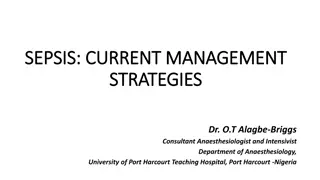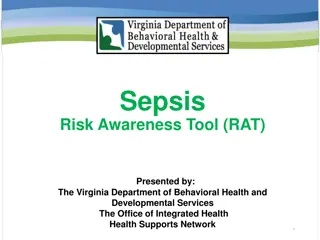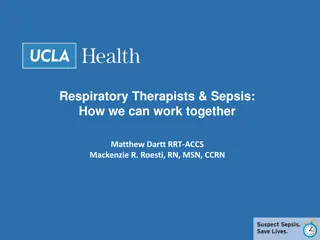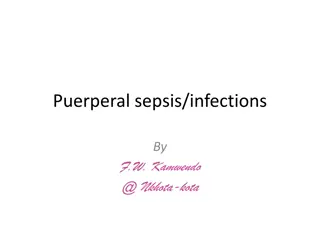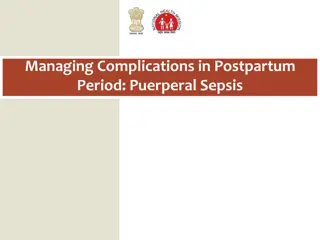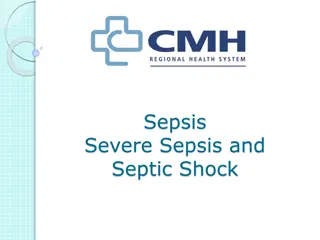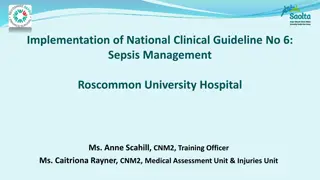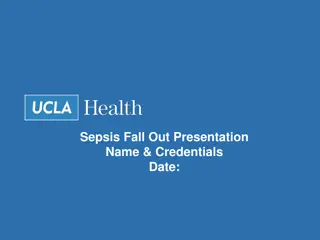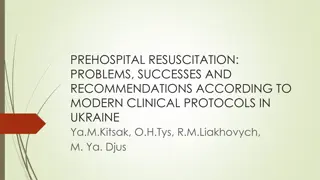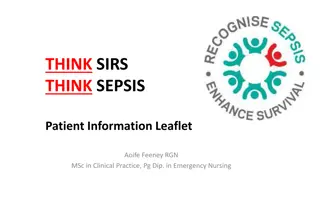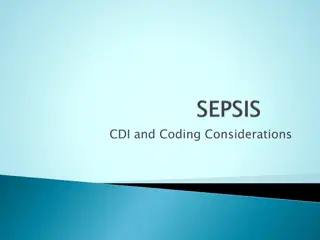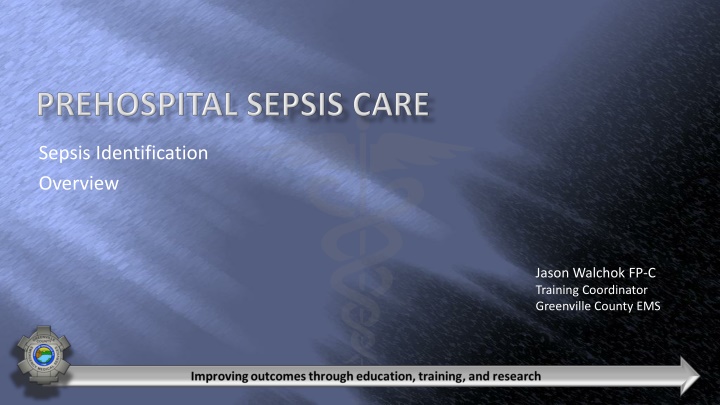
Sepsis: Pathophysiology, Identification, and Treatment
Explore the pathophysiology of sepsis, distinguish sepsis, severe sepsis, and septic shock, learn about SIRS, identify common sources of infection, understand core treatments, and realize the critical importance of early recognition and aggressive treatment of sepsis.
Uploaded on | 0 Views
Download Presentation

Please find below an Image/Link to download the presentation.
The content on the website is provided AS IS for your information and personal use only. It may not be sold, licensed, or shared on other websites without obtaining consent from the author. If you encounter any issues during the download, it is possible that the publisher has removed the file from their server.
You are allowed to download the files provided on this website for personal or commercial use, subject to the condition that they are used lawfully. All files are the property of their respective owners.
The content on the website is provided AS IS for your information and personal use only. It may not be sold, licensed, or shared on other websites without obtaining consent from the author.
E N D
Presentation Transcript
Sepsis Identification Overview Jason Walchok FP-C Training Coordinator Greenville County EMS
Describe the pathophysiology of Sepsis Define Sepsis, Severe Sepsis, and Septic shock Describe systemic inflammatory response syndrome (SIRS) List the common sources of infection presented to EMS List the core treatments for severe sepsis Describe the importance of early and aggressive treatment of sepsis Describe the importance of early identification of sepsis
Comes form the Greek make rotten Broadly defined as an infection in addition to systemic inflammatory response. Typically seen in older adults and those with immune compromise Mortality can be >50%
Severe sepsis and septic shock combined are the 10th leading cause of death in the United States Over 750,000 cases each year Two-thirds initially seen in the ED 215,000 deaths annually 50.37 deaths per 100,000 people Number one leading cause of death in non-cardiac ICU s Melamed et al. Critical Care; 2009 Band et al. Academic Emer Med; 2011 Kaukonen et al. NEJM; 2015
Systemic inflammatory response syndrome (SIRS) A clinical response to a non-specific insult of either infectious or non-infectious origin. Defined as 2 or more of the following: Fever (>101 F) or Hypothermia (<96.8 F) Heart rate (>90 bpm) Respiratory rate (>20 bpm or mechanical ventilations) Signs of poor perfusion (SBP <90 mm/Hg)
Sepsis Systemic inflammatory response to an infection SIRS criteria X2 and source of infection Severe sepsis Sepsis with organ failure Sepsis with lactate > 2.2 mmol Septic Shock Severe sepsis with refractory hypotension Severe sepsis with SBP <90 mm/Hg after aggressive fluid resuscitation Lactate is a measure of tissue perfusion regardless of B/P Decreased oxygenation causes anaerobic metabolism lactate and hydrogen ions are produced
The presence of SIRS does not equal sepsis Also seen in burns, trauma, surgery, autoimmune disorders, or physical exertion. Must identify SIRS and a known or suspected source of infection to be classified as septic. SEPSIS SIRS INFECTION
Sepsis is the number one cause of mortality in hospitalized patients Hypotension + Lactic acidosis >4 = 46.1% Hypotension alone = 36.7% Lactic Acidosis >4 alone = 30.0% Compared to STEMI 30-day mortality rate = 2.5-10% No one questions why we treat STEMI patients aggressively
Capillaries become increasingly inflamed and porous Fluids shift causing hypotension and interstitial edema Pathogens move from the blood into the interstitial spaces spreading infection Systemic vasculature becomes dilated Damaged result in platelet aggregation and clotting cascade Organs clog up resulting in reduced organ perfusion (hypoxia) Disseminated Intra vascular Coagulation (DIC) begins
Tissue injury or pathogen causes stimulation of monocytes to produce regulators. The result is local vasodilation, release of various cytotoxic chemicals and hopefully destroy the invading pathogen. Unfortunately in a small subgroup of pts there is an excessive amount of friendly fire and damage to the pt tissue. mostly the vasculature, so most of the damage is the capillary lining. This is like killing a cockroach with a hand grenade
This reaction intern causes: Vasodilation Reduced stroke volume Microcirculatory failure The infection doesn t necessarily spread throughout the body, the inflammatory response does.
Hyperdynamic state: display a fever; warm, dry skin; tachycardia and tachypnea; mental status changes; and decreased urine output. Hypodynamic state: display either increased or decreased core temperature; cool skin; tachycardia and tachypnea; obtundation; and oliguria. The goal is to support and increase perfusion to organs. The number of organs that fail are a strong indicator of mortality in septic shock. 15% vs 80% mortality when more than one organ is affected.
EMS transports 34% of all patients diagnosed with sepsis, and 60% of all severe sepsis patients arriving to the ED1 Arrival by EMS was is associated with decreased time to IVF and antibiotics2 If sepsis is identified by EMS personnel, the reduction in time to antibiotics initiation is substantial (69 vs 131 minutes)3 EMS Sepsis Alert : severe sepsis mortality significantly decreased (13.6% vs 26.7%)4 1Wang et al. Resus.; 2012 2Band et al. Academic Emer. Med 2011 3Studak et al. AJEM; 2010 4Guerra et al. Journal of EM; 2013
2012 Surviving Sepsis Guidelines Kumar et al. Crit Care Med; 2006 Within one hour of identification For every hour sooner that antibiotics were delivered decreased mortality by 8% per hour Antibiotic therapy within the first hour of severe sepsis recognition contributed to 80% survival Gaieski et al. Crit Care Med; 2010 Dillinger et al. Intensive Care Med; 2013
Antibiotics in severe sepsis: NNT for antibiotics = 1 in 6 NNT for Aspirin in STEMI = 1 in 42 But no one argues the importance of ASA administration in ACS Median time from triage to antibiotic 108 minutes Add 90 min EMS time = 198 Possible 18% reduction in mortality
In most cases EMS providers are in tuned to the presentation of a sick patient needing immediate care. Identifying patients as sepsis upon arrival at the ED can drastically decrease time to antibiotics and early treatment. Prehospital identification and treatment of sepsis has the potential to significantly decrease mortality. Fluid resuscitation Vasopressors to support end organ perfusion Early antibiotics
Methodical and thorough history taking can lead you to a majority of infection sources. SAMPLE, OPQRST, observable signs Regardless of the point of entry, immunocompromised pts are at the greatest risk. Organ transplants, aids/hiv, dm, elderly Most common sources are: Urinary tract Respiratory tract Abdominal Skin / Device
Hx of recent infection Some signs can be masked Beta blockers, pacemaker Recent hospital admission Elderly Including ED and urgent care Immunosuppressed pts Worsening viral-like symptoms General malaise Referred to as cryptic shock, takes a Phd and many hrs to determine. Body ache Decreased appetite Taking antibiotics Elderly
Foley catheter long-term 90% develop bacteriuria Elderly w hx of dm or immunocompromised Unsanitary conditions Frequent or hx of UTI, bladder / kidney infections -Rx antibiotics Symptoms- Sudden and frequent urges to void Burning, irritation, or pain while voiding A feeling of pressure or unable to empty bladder (lower abd, flanks) Thick, cloudy, foul smelling urine Nausea / Vomitting Elderly sudden change in mentation (confusion, delirium)
Pneumonia (PNA) cap, hcap, hap, vap Acquired (community, healthcare, hospital, vent) Bodies inflammatory response to microbial pathogens. Normally reside in oral and nasal mucosa Increased risk Medical devices such as ett, tracheostomies, ng tubes. Aspiration, altered LOC COPD, asthma Smoking Suppressed immune system
Symptoms Progressive onset Fever, sweating and shaking chills Hypothermia is noted in older pts and pts with poor over all health Productive cough (green, yellow, brown) thick and sticky Chest pain when breathing deeply or coughing Shortness of breath Fatigue and muscle ache Nausea, vomiting, diarrhea headache
Leading cause is Peritonitis Bacteria enters the blood stream from an infected organ or ascites Bowel obstructions ischemic Perforations Ulcers Abscesses Diverticulitis Biliary causes gallbladder infection or obstruction Liver disease PID ovarian abscess, ovarian cyst
The key is hx, recent and chronic Pancreatitis, Liver disease, ascites Symptoms Abd cramping pain, guarding Distention Constipation Unable to have a bm n/v/d Abnormal vomit bile, fecal matter Anorexia
When the integrity of the bodies largest protective system is compromised it increases the risk of infection. Burns over large areas of the body (graphs) Penetrating injuries that involve the vasculature Pressure Ulcers Surgical sites, wound dressings Peg tubes Cellulitis Peripherally inserted central catheter (Picc), Central Venous Catheter (CVC)
Early identification is the cornerstone for decreasing mortality Sepsis must be recognized with SIRS criteria x2 and a known or suspected source of infection. Hyper-/ Hypothermia (>101 or <96.8 dF) Respirations >20 Heart rate > 90 bpm Signs of hypoperfusion (SBP<90mm/Hg)
A Thorough and methodical assessment can lead an provider to a source of infection in the presences of SIRS. A known or suspected source of infection with the presentation of SIRS is defined as SEPSIS.

